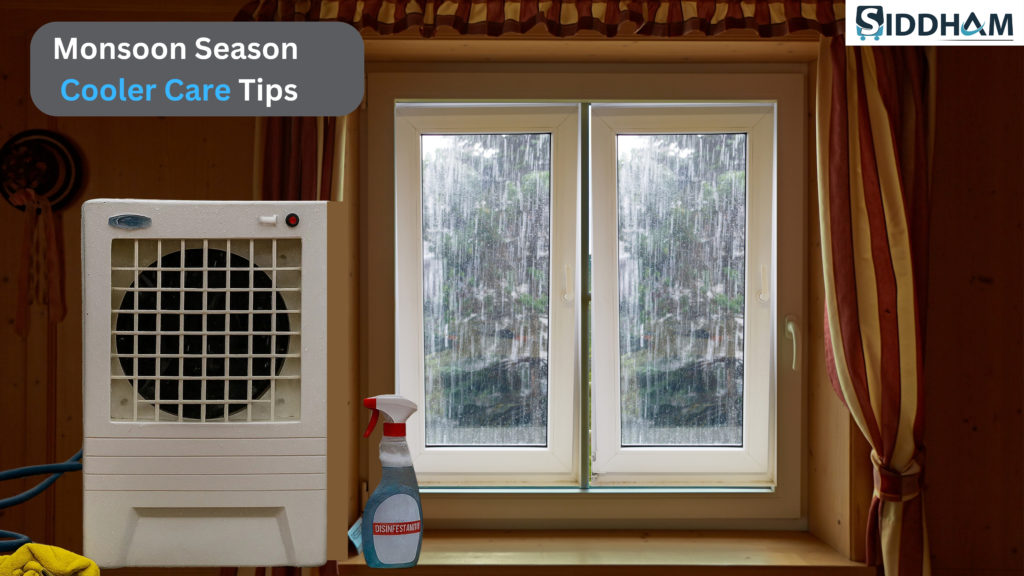Blogs
Monsoon Season Cooler Care: Tips to Prevent Mold & Odor
🌧️Tackle Monsoon Mold: Smart Cleaning Tips for Air Coolers
In a country like India, air coolers are the most economical and eco-friendly solution to beat the heat, especially in dry and semi-humid regions. But come monsoon season, many households experience a common problem: air cooler smell in monsoon, mold buildup, and bacterial growth.
The increased humidity of rainy months leads to moisture retention, which makes your cooler a breeding ground for germs and odors. But don’t worry—this blog provides simple, practical cooler care tips to ensure your cooler remains clean, efficient, and odor-free all through the season.
Let’s keep your home fresh and breathable with a monsoon-ready air cooler.
🦠 Why Coolers Develop Mold and Odor During Monsoon
Humidity is the root cause of most cooling issues during rainy months. Here’s why:
- Excess Moisture: Rainy air is already humid, adding moisture to cooler pads and tanks.
- Stagnant Water: If water stays unused in the tank or pads, it becomes a hub for bacterial growth.
- Dust & Dirt: Unclean air or surroundings bring in particles that accumulate inside the cooler.
- Lack of Ventilation: Using a cooler in closed rooms without exhaust can trap moisture.
⚠️ Signs That Your Cooler Needs Cleaning
Don’t wait for a breakdown. Look out for these signs:
- A persistent musty or foul odor while operating
- Slimy residue in the tank or on cooling pads
- Reduced cooling performance or airflow
- Visible black or green patches inside
These are clear signs of bacterial or fungal buildup that needs immediate action.
🧽 Step-by-Step Guide: How to Clean Your Cooler Properly for Effective Cooler Care
a. Switch Off and Unplug
Always turn off the cooler and disconnect it from the power supply before cleaning. This ensures safety and prevents any risk of electric shock, especially when dealing with water and internal components.
b. Empty the Water Tank
Drain any stagnant water completely. Leftover water, especially during the monsoon, becomes a breeding ground for bacteria, mold, and mosquitoes. Check for any sludge or residue at the bottom and clean it out.
c. Clean the Tank with Disinfectant
Use a solution of white vinegar and lukewarm water (1:1 ratio) or a mild, non-toxic soap. Scrub the tank thoroughly using a soft brush or sponge, focusing on corners, seams, and water lines where algae and mold typically build up.
👉 Pro Tip: Add a few drops of essential oils like tea tree or eucalyptus to prevent future odors and bacterial growth.
d. Clean or Replace Cooling Pads
Cooling pads trap dust, pollen, and moisture — making them highly susceptible to mold during monsoon.
-
To clean: Remove the pads and rinse under running water.
-
For deep cleaning: Soak in a vinegar-water mix for 30 minutes.
-
Replace: If pads are torn, too dirty, or smell even after cleaning, it’s time to replace them for optimal cooling.
e. Wipe Down Fan Blades & Outer Body
Dirt on fan blades affects airflow and cooling efficiency. Use a microfiber cloth dampened with a non-corrosive, anti-bacterial cleaner to wipe fan blades, grills, knobs, and the outer casing. Be gentle to avoid bending the blades.
f. Let It Dry Completely
Before putting everything back, make sure all parts — especially the tank and cooling pads — are fully dry. This prevents mold growth and keeps the air cooler fresh. Leave the lid open and allow ventilation for at least 2–3 hours.
Regular maintenance not only prevents bad odor but also extends your cooler’s life and ensures your family breathes cleaner, fresher air—especially during the damp monsoon months.
💡 Pro Tips to Prevent Mold and Odor in Monsoon
- ✅ Add a few drops of disinfectant or essential oil in the tank.
- ✅ Always use your cooler with open windows for airflow.
- ✅ Clean your cooler at least once a week during monsoons.
- ✅ Use filtered or RO water to prevent mineral and algae buildup.
Popular Queries Covered:
- How to stop bad smell from cooler?
- Best way to clean air cooler at home
📦 Long-Term Storage Tips (If Not in Use During Monsoon)
Planning to skip usage during heavy rains? Here’s what to do:
- Drain all remaining water thoroughly.
- Clean the unit fully.
- Air-dry for a few hours.
- Cover with a breathable cloth or branded cooler cover.
- Store in a dry, shaded space.
🔧 When to Replace Parts or Call a Technician
Don’t wait for total breakdowns. Watch out for:
- The motor is making strange sounds
- Electrical sparks or smell
- The fan is not rotating smoothly
- The water pump is not working properly
Also, cooling pads should be replaced every 6–12 months, depending on usage and water quality.
🆒 Why Choose a High-Quality Cooler for All-Season Use
Investing in a high-quality air cooler ensures reliable performance not just during the scorching summer but also in humid and transitional seasons like the monsoon. Among the best options are fiber coolers, known for their durability, rust resistance, and efficient cooling. Unlike metal coolers, fiber body coolers are lightweight, easy to maintain, and less prone to corrosion, making them ideal for long-term, all-weather use. With proper cooler care, these coolers provide consistent airflow and hygiene, ensuring comfort across seasons.
Siddham Coolers are designed keeping Indian climates in mind. Our models feature:
- Anti-bacterial water tanks
- Removable and washable cooling pads
- Rust-proof outer bodies
- Energy-efficient, all-weather performance
✅ Conclusion
Monsoon can be refreshing, but it brings challenges for cool users. From mold to bad odors, poor maintenance can make your cooler unhealthy and inefficient.
Follow these easy tips for cleaning, weekly care, and smart usage. Your family will thank you for it—with fresh, breathable air all season long.
Siddham Coolers are your trusted companions—built for comfort, performance, and hygiene.

